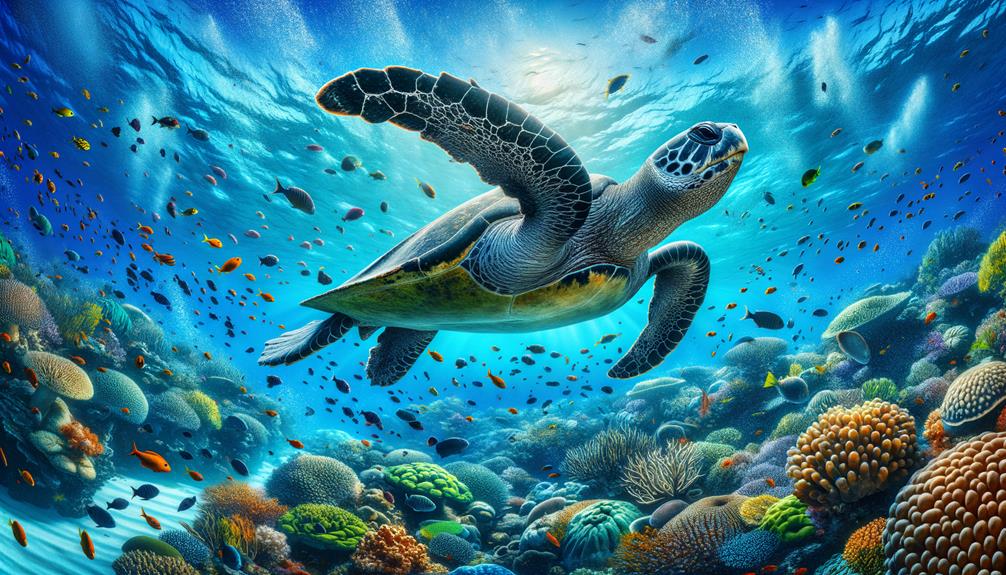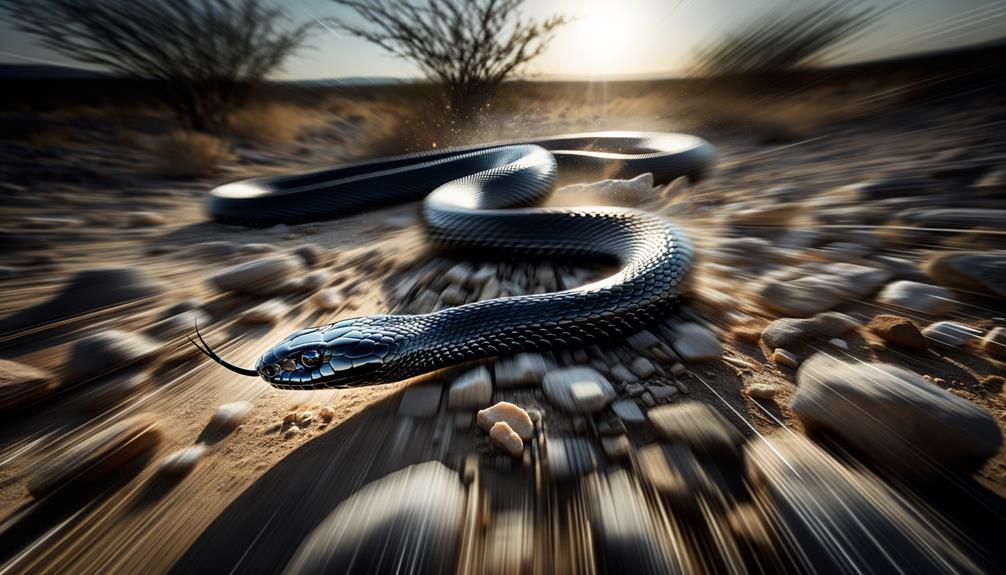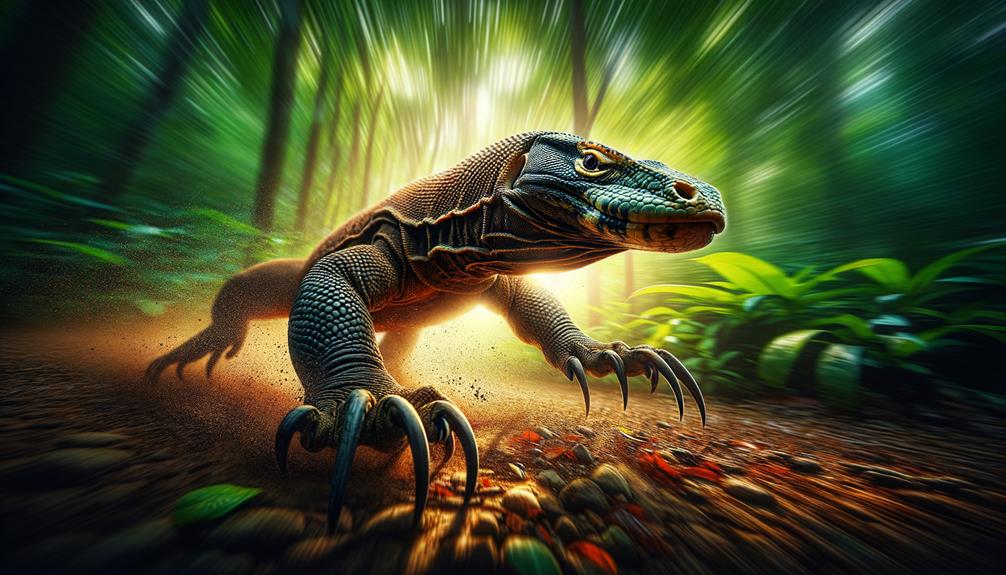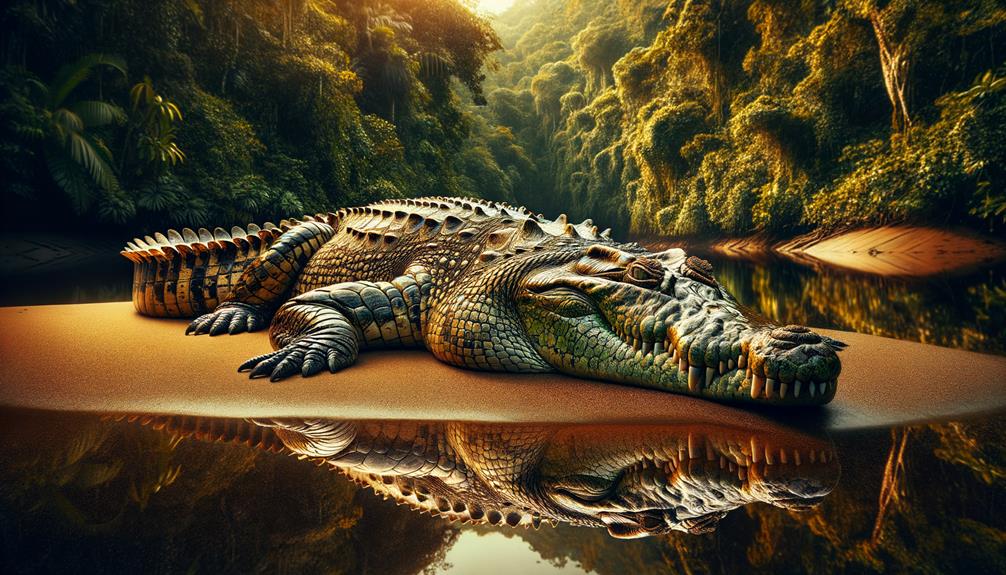I’ve always been fascinated by the incredible speeds some reptiles can achieve. Take the spiny-tailed lizards, which can sprint through deserts at 22 mph using their spiny tails for defense and energy storage. Bearded dragons aren’t far behind, running at 21.9 mph and thriving in diverse Australian terrains. Green iguanas match their pace, leaping through rainforest canopies with powerful limbs. The leatherback turtle is a surprising exception, cruising ocean waters at 21.9 mph despite its large size. These reptiles shatter the stereotype of being slow, and exploring their unique adaptations reveals even more intriguing details.
Key Takeaways
Leatherback turtles are the fastest reptiles on land and in water, reaching speeds of up to 21.9 mph. Their unique skin and ridged carapace contribute to their high speed in the water.
Spiny-tailed lizards can move quickly across deserts, reaching speeds of up to 35 km/h (22 mph).
Bearded dragons are also quick movers, capable of sprinting at speeds of up to 35.28 km/h.
Green iguanas can reach similar speeds, moving at up to 35.28 km/h (21.9 mph).
Spiny-Tailed Lizards
Spiny-tailed lizards, belonging to the genus Uromastyx, can dash across the North African and Middle Eastern deserts at speeds of up to 35 km/h (22 mph). These fascinating creatures, reaching up to 60 cm (24 in) in length, have adapted remarkably to their harsh desert environment. Their distinctive spiny tails serve two purposes: defense against predators and fat storage for energy during lean times.
To survive in such an unforgiving landscape, spiny-tailed lizards have developed unique adaptations. For instance, they’re masters of camouflage, blending seamlessly with the rocky and sandy terrain to avoid detection. Their coloration varies, aiding in this natural disguise. Unlike many other reptiles, they’re active during the day, spending their time basking in the sun to regulate their body temperature.
When the cooler months arrive, these lizards enter a state of dormancy, retreating to their burrows to conserve energy. Despite their impressive speed and adaptations, the conservation status of spiny-tailed lizards varies by species due to habitat loss and degradation. This highlights the delicate balance required to survive in such an extreme environment.
Bearded Dragon

When I think about bearded dragons, I’m struck by their impressive speed – they can sprint up to 35.28 km/h. Their ability to thrive in Australia’s diverse habitats, from Eucalyptus woodlands to arid deserts, has honed their agility and quick reflexes. As omnivorous lizards, they’ve developed remarkable survival skills that enable them to flourish in varied environments.
Speed and Agility
Bearded dragons, with their remarkable ability to reach speeds of up to 35.28 km/h, have honed their speed to perfection. In the wild, every second counts, and these lizards’ swift movements can mean the difference between life and death.
Their agility is not just about raw speed; it’s about precision and control. When a bearded dragon detects a threat, its powerful limbs and streamlined body allow it to dart away almost instantly. This quick burst of speed helps it navigate through various terrains, from dense woodlands to open savannas of Australia.
The bearded dragon’s speed also plays a crucial role in its hunting strategy. By rapidly closing the distance between itself and its prey, the dragon can efficiently capture insects and small animals, ensuring its survival in the harsh environments it calls home.
In essence, the bearded dragon’s speed is a testament to its evolutionary success, finely tuned over millennia to thrive in its natural habitat. This reptile’s ability to move swiftly and decisively grants it the freedom to live and adapt dynamically.
Natural Habitat Adaptations
As bearded dragons zip through their natural habitats, their speed is merely one impressive aspect of their remarkable adaptability. They thrive in diverse environments, from Eucalyptus woodlands to deserts and savannas, thanks to a range of specialized adaptations that help them navigate Australia’s arid and semi-arid regions with ease.
One key adaptation is their ability to store fat in their tails, which serves as a vital energy reserve during times of food scarcity. This stored fat can be a lifesaver when their surroundings offer little sustenance. Additionally, their diet is incredibly versatile, spanning plants, insects, and small vertebrates. This omnivorous feeding behavior ensures they can capitalize on whatever resources are available in their environment.
Bearded dragons’ distinctive “beards” – a bony shell-like structure under their throats – play a crucial role in thermoregulation. By puffing out their beards, they can regulate their body temperature more effectively, which is vital for a cold-blooded creature in fluctuating climates. These combined traits underscore the bearded dragon’s exceptional adaptability, allowing it to flourish across a range of challenging terrains.
Green Iguana

When I think about the green iguana, I’m struck by its impressive speed – it can reach up to 35.28 km/h (21.9 mph). This remarkable agility allows it to effortlessly navigate the treetops of its Caribbean, Central, and South American habitats. Watching these lizards use speed to evade predators offers fascinating insights into their behavior and survival strategies.
Speed and Agility
Green iguanas can move at an impressive 35.28 km/h, showcasing a remarkable blend of speed and agility that’s essential for their survival in their native habitats. Imagine these sleek reptiles darting through the lush foliage of the Caribbean, Central, and South America, their swift movements a reflection of evolutionary mastery. Their ability to navigate treacherous terrain with such grace and precision is truly fascinating.
For green iguanas, speed and agility are vital for:
- Swiftly escaping predators
- Climbing and leaping between branches with ease
- Pursuing prey efficiently
- Evading capture by humans and other threats
Their streamlined bodies and strong, muscular limbs enable these iguanas to reach such high speeds. Unlike the leatherback turtle’s hydrodynamic design, which aids buoyancy, the iguana’s lean, powerful muscles are optimized for rapid terrestrial movement. This agility is crucial for their daily existence, ensuring they can forage effectively and avoid becoming prey themselves.
In the wild, freedom means survival, and for the green iguana, speed and agility are the keys to that freedom.
Habitat and Behavior
In the lush, humid environments of the Caribbean, Central, and South America, green iguanas thrive with remarkable speed and agility. Their vibrant, variable coloration allows them to blend seamlessly into their surroundings, protecting them from predators and aiding in their hunting strategies. Rainforests are their primary habitat, where they can be found basking on branches, showcasing their proficiency as climbers.
These reptiles can grow up to an average length of 4.9 feet, sometimes reaching a record length of 6.6 feet. Their ability to reach speeds of up to 35.28 km/h makes them formidable creatures both on the ground and in the trees. This speed is not just for evasion but also plays a role in territorial displays and mating rituals.
As arboreal creatures, they spend much of their time above ground, traversing the treetops with ease. By observing their behavior, we gain insight into how they’ve evolved to fully exploit their environment. Green iguanas embody a spirit of freedom, moving with an elegance and purpose that speaks to their remarkable adaptability.
Leatherback Turtle

The leatherback turtle’s incredible speed leaves researchers in awe, reaching bursts of up to 21.9 mph, making it the fastest reptile on the planet. It’s hard to imagine a creature weighing over 900 kg (2,000 lbs) and stretching up to 2 meters (6.6 feet) long, yet slicing through the water with such agility.
Unlike its bony-shelled relatives, the leatherback turtle has a unique design featuring thick, leathery skin with distinct ridges on its carapace. This anatomy aids in buoyancy and contributes to its remarkable speed. Daily, these turtles navigate vast oceans, migrating from as far north as Alaska to the temperate waters of South Africa.
Found in tropical and subtropical seas worldwide, they span from Arctic to Antarctic waters. As the last member of the ancient family Dermochelyidae, they’re a surviving ancestor. Their diet consists mainly of jellyfish, which helps control jellyfish populations. Notably, they can regulate their body temperature, allowing them to thrive in colder waters.
The leatherback turtle’s speed and resilience are testaments to nature’s ingenious adaptability.
Black Mamba

Racing across the African savannah at up to 12 mph, the black mamba is one of the fastest and most lethal snakes in the world. Native to parts of southern and eastern Africa, this serpentine sprinter combines speed, agility, and deadly venom to secure its place among the apex predators of the reptile kingdom.
What makes the black mamba so formidable? Let’s take a closer look:
| Aspect | Details |
|---|---|
| Speed | Up to 12 mph (20 km/h) |
| Length | Up to 4.5 meters (14.8 feet) |
| Venom | Potent neurotoxin |
| Behavior | Aggressive and can chase threats over distances |
During the day, these diurnal hunters actively patrol their territory, always ready to defend themselves with their swift movements and potent venom. Their neurotoxin can cause rapid paralysis and death, making them one of the most dangerous snakes to encounter.
The black mamba holds several impressive records in the animal kingdom. As the second-longest venomous snake species, their ability to chase and pursue threats over long distances is unmatched. Their lethal combination of speed and venom means that adventurers need to be vigilant when exploring their habitats.
Komodo Dragon

The Komodo dragon, a formidable predator, rules the Indonesian islands with its massive size and impressive speed. As the largest living lizard, it can grow up to 3 meters (10 feet) in length, a size that commands respect. But what really sets it apart is its ability to sprint at speeds of up to 20 km/h (12.4 mph), making it one of the fastest reptiles on Earth.
Native to the islands of Komodo, Rinca, Flores, and Gili Motang, these apex predators use their speed and power to hunt a variety of prey, including deer, wild boar, smaller Komodo dragons, and carrion. With their sharp teeth and powerful jaws, they are efficient and deadly hunters, capable of capturing and consuming large prey with ease.
Despite their dominance in the wild, Komodo dragons face significant threats, including habitat loss and human hunting, which have classified them as vulnerable. It’s crucial that we take vital efforts to ensure these remarkable reptiles continue to roam their native lands. Their future is in our hands, and it’s time we honor their place in the animal kingdom.
Frequently Asked Questions
Which Reptile Swims the Fastest?
Like a torpedo slicing through the ocean, the leatherback sea turtle is the fastest reptile swimmer out there. It can reach incredible burst speeds of up to 35.28 km/h, a truly mind-blowing feat.
What Is the Fastest Lizard on Land?
The fastest lizard on land is the spiny-tailed lizard, capable of reaching speeds of up to 35 km/h. Found in North Africa and the Middle East, this agile creature relies on its speed to hunt and evade predators.
Are Turtles the Fastest Reptile?
Turtles aren’t the speed demons of the reptile world. While leatherback sea turtles can swim at impressive speeds, some lizards, like the spiny-tailed lizard, can outrun them on land. Speed varies greatly depending on the habitat and species, with turtles exceling in aquatic environments.
What Is the Fastest Reptile in Africa?
The fastest reptile in Africa is the spiny-tailed lizard, capable of reaching speeds of up to 35 km/h. What’s fascinating about these lizards is how they’ve adapted to thrive in harsh desert conditions, using their powerful limbs and spiny tails to survive.



